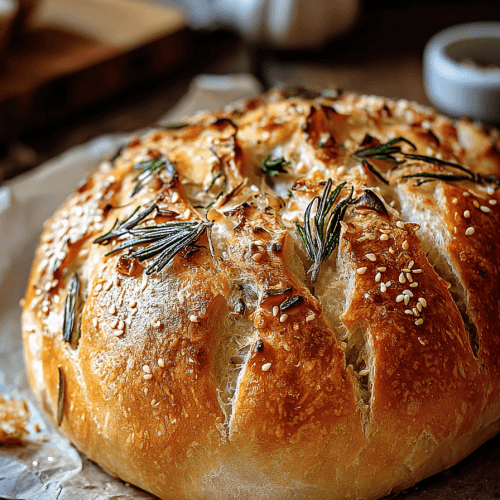
Easy Roasted Garlic Rosemary Bread – The Best Homemade Loaf
An aromatic, no-knead artisan loaf featuring roasted garlic and fresh rosemary. The result is a crusty, golden exterior with a soft, chewy interior—ideal for any meal or as an elegant centerpiece on the table.
Ingredients
For the Bread Dough:
- 1 whole head of garlic
- 1 tablespoon extra-virgin olive oil divided
- Coarse sea salt and freshly ground black pepper to taste
- 1½ cups water room temperature (approximately 70°F / 21°C)
- 1 teaspoon active dry yeast
- 3 cups bread flour or all-purpose flour plus extra for dusting
- ½ teaspoon dried oregano
- 1 teaspoon kosher or fine sea salt
- 2 teaspoons finely chopped fresh rosemary plus additional for garnish
- 1 head of roasted garlic cloves lightly smashed
Instructions
- Roast the Garlic: Preheat the oven to 400°F (204°C). Slice the garlic head horizontally, drizzle with olive oil, and season lightly with salt and pepper. Wrap in foil and roast for 40 minutes, or until the cloves are golden and tender. Cool, then squeeze the roasted garlic from its skins.
- Activate the Yeast: In a small bowl, combine the yeast with room-temperature water. Allow it to stand for 10–15 minutes, until slightly foamy and aromatic.
- Prepare the Dough: In a large mixing bowl, combine flour, salt, oregano, and chopped rosemary. Add the yeast mixture, roasted garlic, and remaining olive oil. Stir gently with a spatula until the dough forms a sticky, cohesive mass.
- First Fermentation: Cover the bowl with a clean kitchen towel and allow the dough to rest at room temperature for 8–10 hours, or until it doubles in volume.
- Shape and Refrigerate: Transfer the risen dough onto a lightly floured surface. Shape it carefully into a smooth ball without over-handling. Place seam-side up in a floured bowl or banneton, cover, and refrigerate for 1–24 hours (up to 48 for enhanced flavor).
- Preheat and Score: Place a Dutch oven (with its lid) in the oven and preheat to 450°F (232°C). Once preheated, remove the dough from the refrigerator, invert it onto parchment paper, and score the surface with a sharp blade or lame.
- Bake the Bread: Carefully lower the dough (with parchment) into the heated Dutch oven. Cover and bake for 30 minutes. Remove the lid and continue baking for an additional 15–20 minutes, until the loaf is deep golden brown and crisp.
- Cool and Serve: Transfer the baked loaf to a wire rack and allow it to cool completely for at least one hour before slicing. Serve warm or at room temperature to enjoy its full aroma and texture.